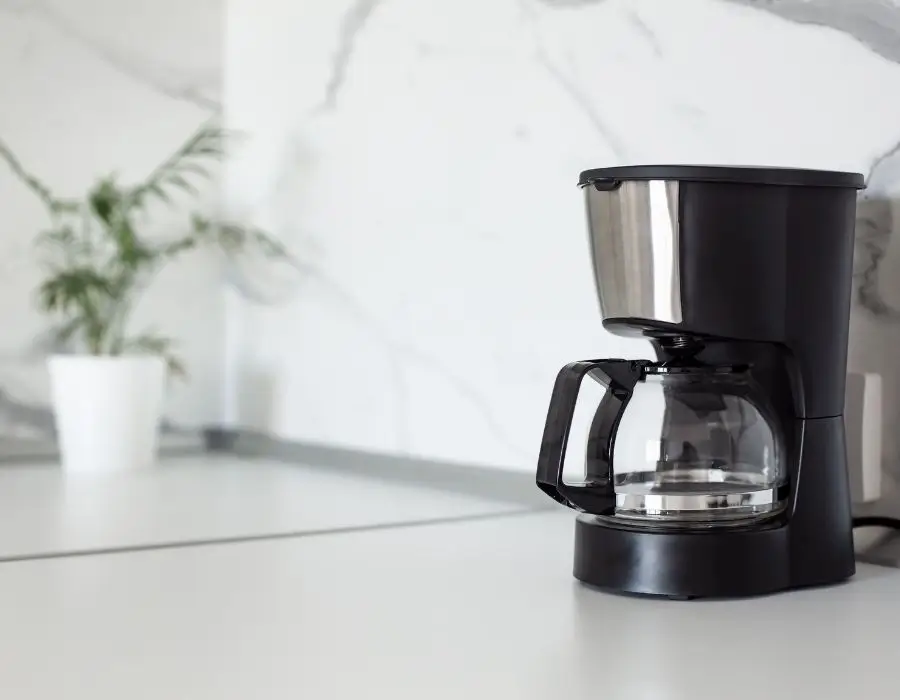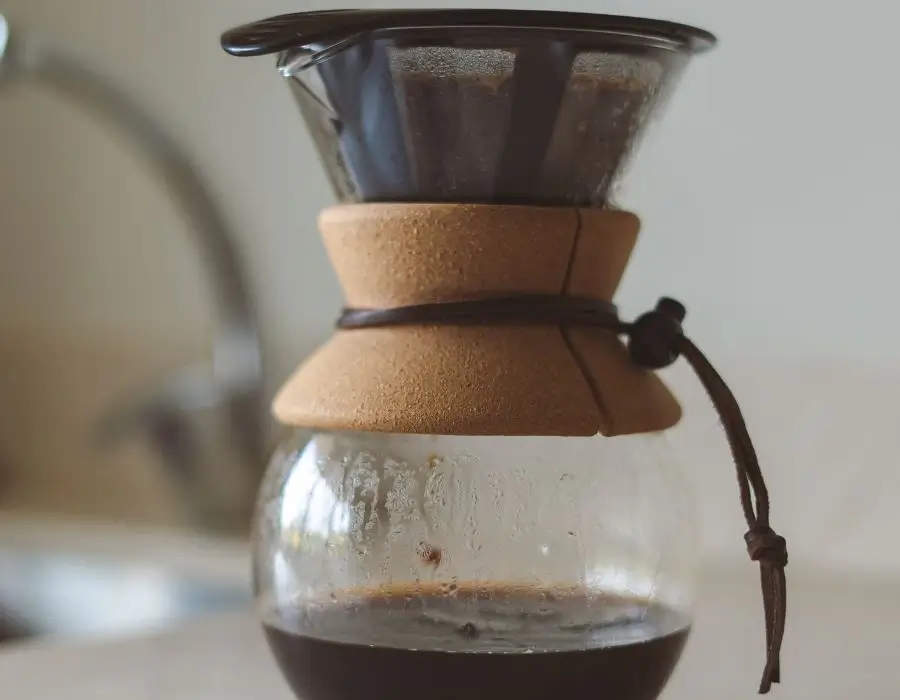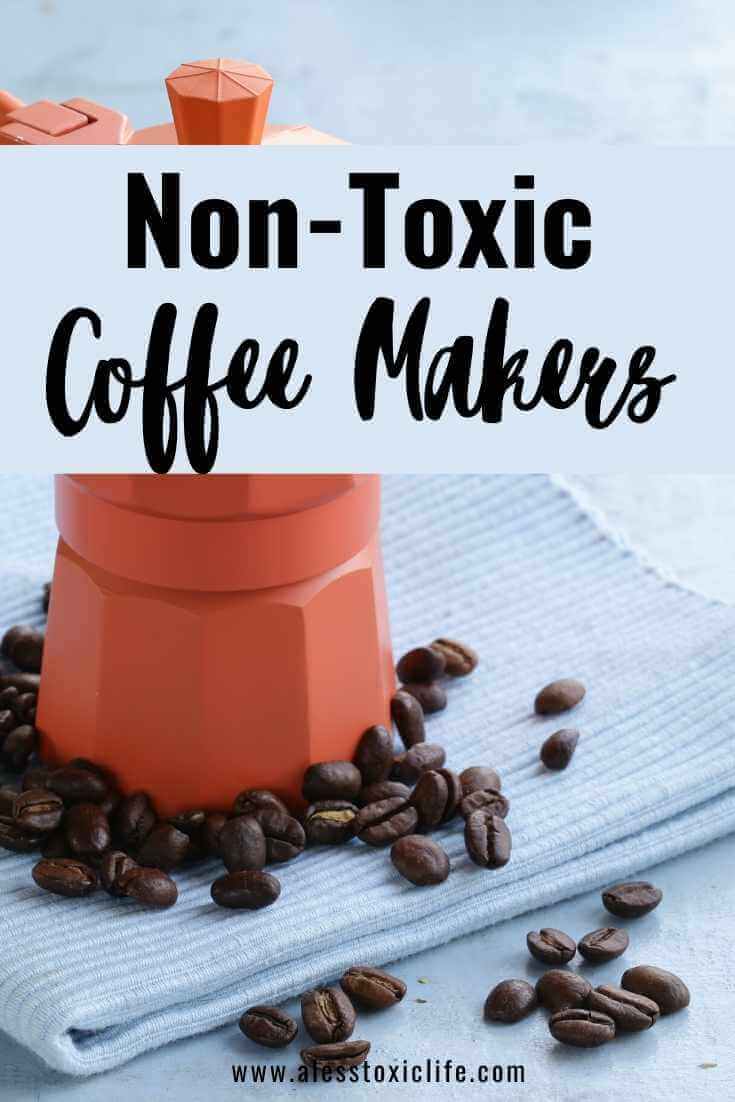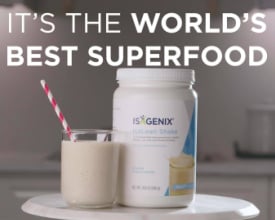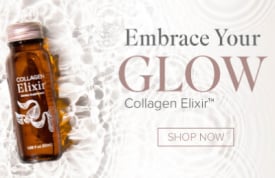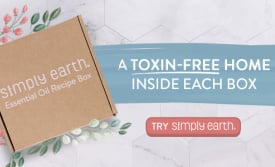So I admit I love coffee in the morning and over the last few years, I’ve gotten my husband addicted, too.
We’ve discussed numerous times if coffee is healthy for us and as you probably know it depends on who you listen to.
So we decided to drink only organic coffee and limited it to 2 cups a day.
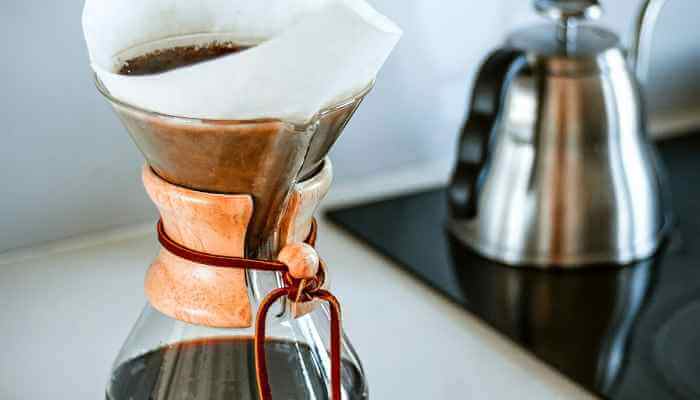
But there is something I realized lately that I’ve shockingly paid little attention and that is how I make our coffee.
I mean, I’ve been particular about my organic coffee – where and how it’s grown but I hadn’t been meticulous about our coffee maker (except I did return my Keurig after I learned about the potential issues with them).
When I researched the importance of the maker itself and potential toxins I was a little annoyed at myself for not thinking about it earlier.
So to help you avoid the potential toxins, I’ll share with you some things I learned I needed to watch out for and some plastic-free and “toxic-free” coffee makers to check into.
A Quick Checklist For Your Coffee Maker
Here are some points that deserve our attention when making our morning brew.
1. Does The Coffee Maker Have Plastic?
Plastic is an incredibly versatile material that finds widespread use practically everywhere. It is omnipresent, and yes, it is likely in your coffee maker as well.
For many coffee makers, even the water heating chamber and associated tubing could be made of plastic.
And there’s the rub.
Users often complain that their new coffee maker adds a “plastic smell” to their coffee.
Well, that’s because chemicals are leaching from the coffee maker into the coffee.
I don’t mean to be alarmist, and that smell doesn’t necessarily represent a health hazard.
However, it is a clear indication that substances that shouldn’t be in your coffee have found their way into it.
Plastics – Here’s What You Should Be Wary Of
When it comes in contact with hot water, plastic can leach chemicals into the water.
The most worrisome of these chemicals are phthalates and BPA.
Phthalates are troublesome carcinogenic chemicals that you want nowhere near your body.
There is a minimal chance of phthalates being in modern coffee makers due to better legal requirements and awareness.
However, if your trusty old coffee maker uses plastics and is from somewhere near 2010 or earlier, chuck it out.
There’s a good chance its tubing uses PVC plastics, which in turn rely on phthalates.
The bigger worry for modern coffee makers is the use of BPA (Bisphenol-A) in coffee makers.
BPA is an endocrine disruptor that can leach into water and coffee. In response to this problem, many manufacturers offer “non-toxic” BPA-free coffee makers.
Turns out, many of these BPA-free plastics might rely on other chemicals that are just as harmful.
To be fair, there are companies that use high-quality plastics that are toxin-free.
For the average buyer, the hype around BPA-free might obscure the concern for other chemicals.
At What Points Does The Coffee Maker Use Plastic?
The problems with plastic are at points where it comes in contact with hot water.
If you get a coffee maker where plastic never comes in contact with hot water, it’s as good as a plastic-free coffee maker.
It’s irrelevant if the external body or buttons are plastic or some other material.
The pertinent point is that plastic should never touch hot water, whether it’s the reservoir, tubing, or filter.
Similarly, high-quality plastics that don’t leach chemicals into the water can also be considered non-toxic.
2. Don’t Switch From Plastic To Aluminum
Coffee makers going for a metallic touch to avoid plastics sometimes end up choosing aluminum because it’s a cheaper material and has been used in coffee makers for a long time.
However, modern understanding demands that users stay away from aluminum.
It may not be tagged as toxic, but it isn’t good for your health.
Aluminum corrodes when in contact with the coffee, enters the coffee, and can have adverse effects on your health.
For one, consuming aluminum makes it difficult for the blood to absorb iron and can cause anemia.
It has also been linked to kidney problems, Alzheimer’s disease, and dementia.
It is worth noting that aluminum absorption problems are relevant only when using uncoated aluminum.

3. Clean And Maintain Your Coffee Maker
Proper cleaning and maintenance of your coffee maker is very important and even more so when you’re using a drip coffee maker or similar machine.
Dirty spots inside the machine will not be visible to the user.
Many people also believe that since the coffee maker deals with hot water, it will kill off any germs or fungi.
That is an incorrect belief.
Coffee makers don’t heat water to a high enough temperature to effectively kill off yeast, fungi, and bacteria.
Additionally, the temperature isn’t maintained long enough to be effective.
One troublesome statistic suggests that more than half of home coffee makers have yeast or fungi in the water reservoir.
As deposits build up due to scaling, these troubling elements get more places to hide and grow.
So make it a point to clean and descale your coffee maker regularly.
The exact timing depends on the manufacturer’s recommendations and your use of the machine. If you’re not sure, try to clean it at least every two months or so.
What’s A Suitable Non-Toxic Material For Coffee Makers?
The best choice of non-toxic materials for coffee makers are stainless steel and glass.
Both of these are non-toxic materials and don’t interfere with the taste or flavor of the coffee.
Both of these materials are safe to use with coffee makers and high-end manufacturers make conscious attempts to use these two materials for their coffee makers.
Porcelain is a non-toxic material as well but it isn’t widely used in regular coffee makers.
If you find yourself invested in picking a non-toxic coffee maker, the best choice is to go low-tech.
These coffee makers are relatively inexpensive compared to drip coffee makers or espresso machines. They’re easier to maintain, and you have a better chance of knowing what materials are used and come in contact with your coffee.
The only downside is that these coffee makers require more manual work.
Generally, this means you’ll have to heat the water yourself and work the extraction process (depending on the coffee maker).
This isn’t too much work, and if you can spare a few extra minutes, it’s no trouble at all.
Special Reminder:
If you can’t buy a new coffee maker consider making the switch to organic coffee, which is something you can do without as much effort.
Dive Deeper Into How Toxins Affect Us
If you want more information about the danger of BPA plastics and toxins in our coffee and other household items watch this video.
I learned a lot and was surprised that even toxins in our bedding can contribute to weight gain!
Top Non-Toxic Coffee Makers
So here are some non-toxic coffee maker options for you.
There are other plastic-free options I need to investigate but haven’t gotten to them yet.
If you have any of these or another brand, please leave me a comment below because I would love to hear your review.
I’ve included video reviews or directions for the ones I could find.
1. CHEMEX Pour Over Coffee Maker
Very likely the most popular pour-over coffee maker, CHEMEX can also boast of being non-toxic.
The coffee maker itself is made out of borosilicate glass. This material doesn’t absorb odors or chemicals from the coffee it brews. and doesn’t add odor or chemicals to the coffee.
That way, you get excellent, flavorful coffee without having to worry about your coffee maker adding toxins to the coffee.
CHEMEX Pour Over Coffee Maker is available in two variants.
These are a handle variant, and a handleless option where an insulating band is placed at the neck of the coffee maker.
I think the latter looks cooler and is more elegant.
When using this coffee maker, it is important to make your choice of filter carefully.
Chemex uses paper filters so using a good quality filter ensures that your coffee remains toxin-free. The manufacturer recommends using Chemex bonded filters.
See this CHEMEX Pour Over Coffee Maker on Amazon
2. Eurolux Percolator Coffee Maker Pot
Percolators are well-known for their propensity to brew strong, caffeine-rich coffee.
Since percolators are supposed to go over a flame, they generally don’t use plastics.
If you want a percolator, the smart choice is to get it in stainless steel and the Eurolux Percolator Coffee Maker Pot fits that description to a tee.
This percolator is made from food-grade 18/8 stainless steel. and won’t absorb flavors from coffee or deliver chemicals into your brew.
Eurolux Percolator’s stainless steel body will happily sit over any stove or flame you choose to employ.
It’s portable and great for brewing coffee when you’re out camping.
Better yet, it’s a great option to use at home.
Incidentally, percolators were the preferred coffee brewers in the USA until the more convenient drip coffee maker came along.
See this coffee maker on Amazon
3. BUNN VP17-1SS Pourover Coffee Brewer
If you must use a drip coffee maker, take a look at the BUNN VP17-1SS Pourover Coffee Brewer.
This is a well-regarded coffee maker where plastic never comes in contact with hot water. Its innards are metallic and don’t include any potentially toxic substances.
According to the company, the only non-metallic material from the water reservoir to the spray head are a couple of food-grade silicone grommets.
The trouble with this machine is that the filter assembly is plastic but stainless steel filter assembly is available and can be purchased separately.
You’ll also need to buy the funnel tip kit.
Both these additions push up the cost of the already expensive coffee maker by quite a bit.
On the plus side, you get a good quality, non-toxic coffee maker.
See this coffee maker Amazon
5. Technivorm Moccamaster 59162 KBG Coffee Brewer
Technivorm Moccamaster 59162 KBG Coffee Brewer is a high-quality coffee maker with a very attractive design.
This is not a plastic-free coffee maker.
However, it is worthy of being considered a non-toxic coffee maker.
The company says only high-quality plastics are used and they don’t add any harmful chemicals into the coffee.
Moccamaster 59162 KBG has separate switches for the coffee maker and hot plate.
The coffee maker switch works as a conventional on/off switch. The hot plate switch acts as temperature control and switches the plate from a lower to a higher temperature.
See this coffee maker on Amazon
6. Bean Envy Cold Brew Coffee Maker
Love cold brew coffee? You’ll love this coffee maker too.
Bean Envy Cold Brew Coffee Maker has excellent construction with a borosilicate glass body that sits on a non-slip silicone base, a stainless steel filter, and silicone cap.
There is less to worry about since this is a cold-brew coffee maker.
Even so, it is reassuring to know that it sticks with non-toxic components.
See this coffee maker on Amazon
Bottom Line
As common as coffee makers are, they don’t always use the best quality materials.
Using lower-quality materials or poor maintenance can introduce unwanted, or even toxic chemicals into the coffee, so we need to be as particular about the maker as we are the coffee beans we use.
Let me know if you use any of these coffee makers or if you have a favorite one I haven’t checked into yet.
I’m still testing them out so I’ll be back with an update and would love your input!
Remember: If you can’t buy a new coffee maker right away you should consider at least making the switch to organic coffee.


